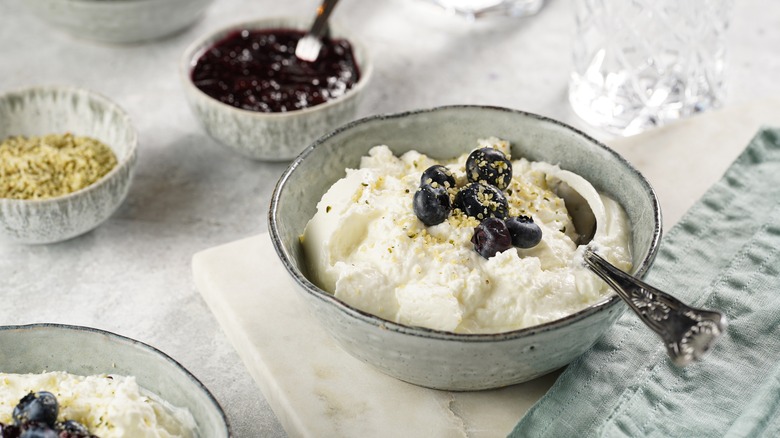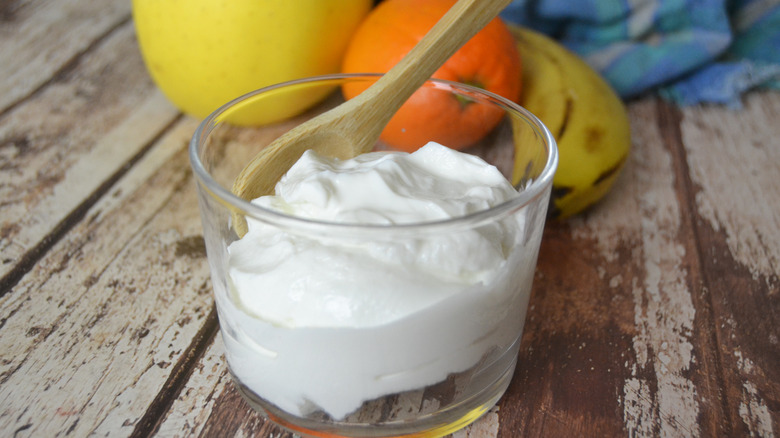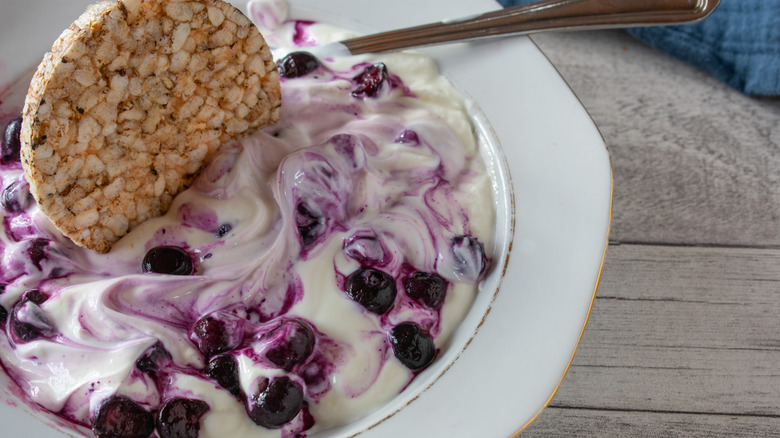Is Icelandic Skyr A Type Of Yogurt Or Cheese?
Yogurt takes on many different forms, depending on what country you're in. While American yogurt is nutritious and comes in a plethora of flavors, it's important to read the label when buying yogurt, as many varieties in the U.S. sneak in tons of sugar. Other countries' varieties may offer healthier options, however. We know by now that Greek yogurt is chock-full of protein and can act as a more nutritious substitute for mayo and ranch, while Bulgarian yogurt is fermented, giving you all those good-for-your-gut probiotics.
And if you travel all the way to Iceland — or just check out the dairy section at major grocery stores — you may be able to find Icelandic skyr. This version also packs a nutritional punch — just one serving of skyr has a whopping 17 grams of protein, along with only 110 calories and only 2 grams of fat. And in addition to being protein-rich, skyr may improve bone health, support a healthy gut, and help your muscles function, according to Verywell Fit.
Skyr has a similar nutritional profile to Greek yogurt — and while it's white, creamy, and typically eaten with a spoon, you may be surprised to learn that skyr isn't actually yogurt at all.
How is skyr made?
Skyr is thick, creamy, and delicious, so you may never guess it's made with skim milk. Skyr is made by removing the cream from skim milk, heating it up, and adding live bacteria, making the dairy product good for your gut. In modern times, you buy a live culture from a specialty shop, heat it, and mix it with milk. But back in the day, a simpler method was used.
As Icelandic cookbook author Gunnar Karl Gíslason told Iceland Mag, "Back in the old days, people would pour skimmed milk into a container and leave it outside until the bacteria needed to make skyr had begun to form." People would leave it in various places — "down by the seashore, in little hollows, or high up on heaths," Gíslason explained.
Traditional skyr was also recycled, as people would use a little from their previous batch to mix with warmed milk and create more. And while it is a dairy product, true Icelandic skyr is a cheese rather than a yogurt. When heating the milk, skyr makers add rennet, an enzyme that coagulates milk and separates the curds from the liquid whey in cheese. After the bacteria has formed, a cloth filters out the whey. In the U.S., however, bigger companies forgo rennet, which may be why it's often marketed as yogurt.
How skyr is eaten in Iceland vs. the U.S.
Skyr has been made in Iceland since Norse people settled in the country during the Viking Age, and it's still a staple in Icelandic diets today. Traditionally, Icelanders eat it for breakfast, as a snack, or with toppings as dessert. It can be eaten simply, with cream and fresh fruit, although in modern-day Iceland, a wide variety of mix-ins are added to complement the tart flavor of skyr — oats, jam, cookies, brown sugar, and Nordic fruits are just a few. Some Icelanders even use it to top off cheesecakes or as a base for smoothies.
In the U.S., we've adopted skyr as another variety of yogurt available here, partly because it's marketed as such. We tend to make yogurt bowls with the cheese, topping them with the usual suspects: fruit, granola, and honey. But similar to Greek yogurt, skyr can be used in a plethora of ways in American cuisine — it can be a replacement for sour cream or mayo in dips and dressings, spread on your pancakes or waffles, or used to add creaminess to pasta sauces.
But if you want to eat it like the Icelanders do, try pouring cream over a bowl of skyr for a sweet-tart flavor combination. As former MS Iceland Dairies CEO Einar Siggurdson told The Kitchn. "It's very important not to stir it together but to experience the two different flavors and sensations."


